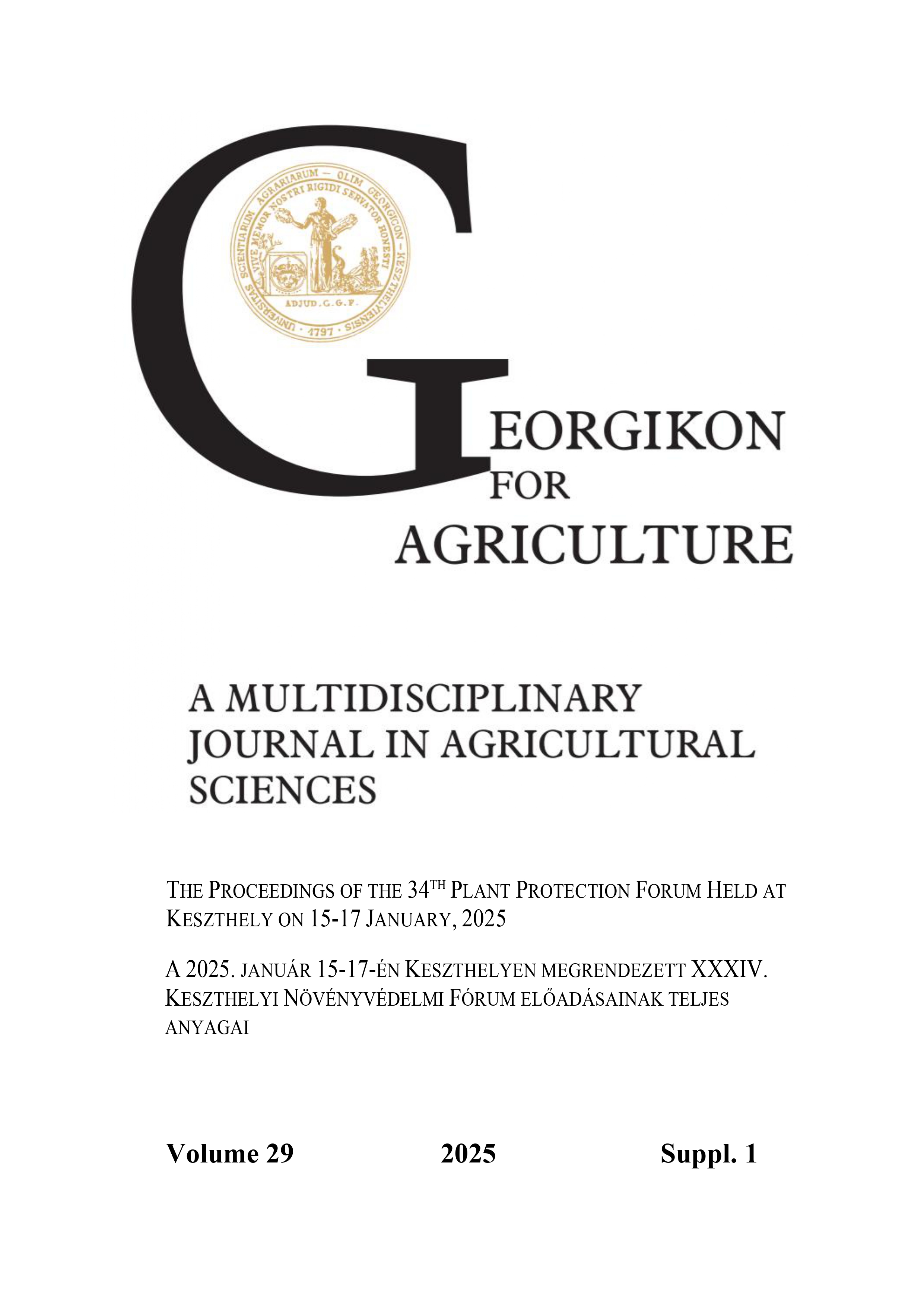A biológiai védekezés hatékonysága a rózsás meténg (Catharanthus roseus) talajból fertőző kórokozói ellen
DOI:
https://doi.org/10.70809/6577Kulcsszavak:
Madagascar periwinkleis, Trichoderma asperellum, fuzáriumos hervadásAbsztrakt
A rózsás meténg (Catharanthus roseus L.) termesztését számos kórokozó befolyásolja, beleértve a talajból fertőző kórokozókat is, mint például a Fusarium, Phytophthora vagy Pythium fajokat. Egyre inkább előtérbe kerül a biológiai növényvédőszerek használata a kémiai növényvédőszerek hatóanyagainak folyamatos kivonása miatt. A kórokozók elleni védekezésben egyre gyakrabban használnak antagonista szervezeteket, mint a Bacillus amyloliquefaciens, a Trichoderma asperellum és a T. atroviride. Ebben a tanulmányban a T. asperellum in vitro hatékonyságát vizsgáltuk F. oxysporum ellen. A konfrontációs teszt során a F. oxysporum növekedését jelentősen gátolta az antagonista gomba. Ez előrevetíti T. asperellum használatának a lehetőségét C. roseus termesztésében F. oxysporum ellen. Alkalmazása csökkentheti a kémiai növényvédő szerektől való függőséget és elősegítheti a fenntartható mezőgazdasági gyakorlatot
Hivatkozások
Farr, D. F., Rossman, A. Y. and Castlebury, L. A. 2021. United States National Fungus Collections Fungus-Host Dataset. Ag Data Commons. Dataset. https://doi.org/10.15482/USDA.ADC/1524414
Ghanbarzadeh, B., Safaie, N. and Goltapeh, E. M. 2014. Antagonistic activity and hyphal interactions of Trichoderma spp. against Fusarium proliferatum and F. oxysporum in vitro. Archives of Phytopathology and Plant Protection. 47 (16) 1979–1987. https://doi.org/10.1080/03235408.2013.864506
Larran, S., Santamarina Siurana, M. P., Roselló Caselles, J., Simón, M. R. and Perelló, A. 2020. In vitro antagonistic activity of Trichoderma harzianum against Fusarium sudanense causing seedling blight and seed rot on wheat. ACS Omega. 5 (36), 23276–23283. https://doi.org/10.1021/acsomega.0c03090
Monte, E. 2001. Understanding Trichoderma: between biotechnology and microbial ecology. Int Microbiol. 4 (1) 1-4.
R Development Core Team. 2019. R: a language and environment for statistical computing. https://www.r-project.org/
Singh, S., Kumar, R., Yadav, S., Kumar, R., Kumari, P., and Singh, R. K. 2018. Effect of bio-control agents on soil borne pathogens: A review. Journal of Pharmacognosy and Phytochemistry. 7 (3), 406–411.
Woo, S. L., Ruocco, M., Ciliento, R., Ambrosino, P., Marra, R., Vinale, F, Lanzuise, S., Turrá, D., Soriente, I., Gigante, S., Scala, F. and Lorito, M. 2007. A novel understanding of the three-way interaction between Trichoderma spp., the colonized plant and fungal pathogens. In G. D. Robson, P. van West, & G. Gadd (Eds.), Exploitation of Fungi (pp. 291–309), Cambridge: Cambridge University Press. https://doi.org/10.1017/CBO9780511902451.017
Yasir, B. L., and Almaliky, B. S. A. 2023. Integrated control of root rot and wilt disease on Catharanthus roseus using biological and chemical control. Iraqi Journal of Market Research and Consumer Protection. 15 (1) 132–146. https://doi.org/10.28936/jmracpc15.1.2023.(12)
Letöltések
Megjelent
Folyóirat szám
Rovat
License
Copyright (c) 2025 Szendrei Lilla, Borsos Dóra Piroska , Petróczy Marietta, Markó Gábor, Tóth Annamária

This work is licensed under a Creative Commons Attribution-NonCommercial-NoDerivatives 4.0 International License.
The articel is under the Creative Commons 4.0 standard licenc: CC-BY-NC-ND-4.0. Under the following terms: You must give appropriate credit, provide a link to the license, and indicate if changes were made. You may do so in any reasonable manner, but not in any way that suggests the licensor endorses you or your use. You may not use the material for commercial purposes. If you remix, transform, or build upon the material, you may not distribute the modified material. You may not apply legal terms or technological measures that legally restrict others from doing anything the license permits.




 Georgikon for Agriculture
Georgikon for Agriculture